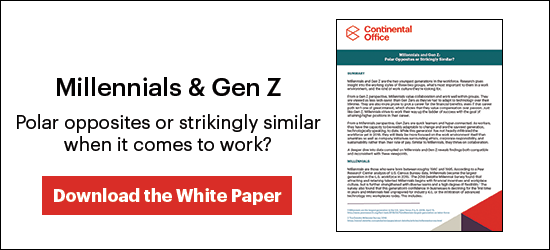Who is Gen Z? Are they really that different than other generations in the workplace? Do we need to plan differently and consider what their expectations will be as they continue to enter the full-time workforce? The answer is undoubtedly yes! It’s an exciting time, because for the first time in modern history, five generations now coexist in the workplace. In fact, by next year, Gen Z will account for 20% of the workforce. We spoke with our Gen Z interns from The Ohio State University to get their take on entering the workforce and how they think about space.
Meet our team:
Q: Is it accurate to say you prefer a balance between technology and human interaction? How important is it for you to have human interaction/ face-to-face conversations at work?
Carly
A: I like a mix of technology and face-to-face interaction. I like hearing information straight from the source, rather than through email or other technological modes. But I also really appreciate when technology can aid the human interaction. Whether that is getting on a conference call with someone in another state or face-timing, I think the two modes of communication work best when they pull from each other and are used together. I also like to build a good relationship with my coworkers and see as many faces as I can (especially in a new position), so the face-to-face interaction really helps in this aspect. You’re more likely to remember meeting someone in person than over email or a phone call, so I appreciate the interaction. But there are also times that I just want to have heads-down work time. I also listen to music and podcasts while I work, which I couldn’t do without technology.
Maddie
A: Definitely agree with this! I like to work by myself to actually get things done but talking to coworkers and colleagues is necessary for productivity and avoiding monotony.
Nick
A: I would say this is true for me, yes. As a graphic designer — and this holds true in other fields as well — I rely on technology and computers to accomplish about 95% of the work that I do. I even have a special section on my resume to call out my software skills because of how standardized an understanding of the technology has become in the industry. That being said, the software is merely a tool designers use to create. Because of this, it is absolutely crucial that conversations are happening throughout the day in order to get more opinions, critiques, and to spark inspiration for new ideas. We’ve all heard the phrase “great minds think alike,” but it is incredibly more beneficial when great minds are thinking together.
Taylor
A: Yes, I like to have a balance between the two. I think technology is a very necessary part of work and it is also a useful tool in face-to-face interactions. Human interactions at work are very important for me because I am very social and I enjoy talking and getting to know others. I also think it is possible for communication through email to be misinterpreted or confusing, so knowing I can talk to my coworkers helps to avoid the potential miscommunication issues. In addition, human interaction is an important part of making me feel like I fit in at work. Building relationships with coworkers through face-to-face interactions is something that makes coming to work a lot more enjoyable.
Q: What is your preferred office layout? Why?
Carly
A: I like the open layout, which is how our desks in design are laid out. I think it keeps me more focused – one because people can see my screen and two because I can see what my coworkers are doing and that keeps me motivated. But, I do like the use of screens and tack boards to provide a sense of privacy and boundary. I can see the appeal of a private office if you are dealing with more sensitive information or need a consistent meeting place, but I also like getting up and walking around to go to meetings. Being in a new space throughout the day gives a change of scenery and I think this is important when you might be stuck at your computer for long hours. Another aspect of the open office I like is the ability to collaborate with my coworkers. Especially since as an intern, I am helping many designers with their projects and need to ask them specific questions a lot. So most of the time I can just turn around in my chair and ask a quick question. I also just like the aesthetic of the open office. It breaks up the typical cube look and makes things seem a little cleaner. I know if I had a cube or a private office I would probably have more junk throughout my work space that I wouldn’t necessarily need.
Maddie
A: I like having multiple places to work. A desk and monitor allows for the best type of “heads down” work to get done while in a more relaxed environment even outside or in front of a TV is good for sending emails and making calls.
Nick
A: I think a flexible workspace is the way to go. Given advancing workplace technology, specifically those allowing entire teams to work from one wireless system drive, a space like the Continental Chestnut Studio is a great example of how my ideal workspace would function. The branding team sits together in one large open section of the office, but anyone is welcome to work in the huddle rooms or the Hopewell space if they prefer to work more privately. This allows each member of the team to work in whatever environment will be most conducive on any given day.
Taylor
A: I enjoy working in a variety of places. Sometimes I prefer to have some privacy if I am working on a task I really need to focus on. I appreciate the flexibility of being able to work in many different spaces because it enables me to choose to sit by windows and places that have more natural light. At Continental Office I feel very spoiled with the two screens I have at my work station. The dual monitors make every task a lot easier.
There's not a one-size-fits all solution, but it seems safe to say that technology will never replace face-to-face interaction, and choice and flexibility in when and where you sit is critical to keeping happy Gen-Zers engaged.
Want to learn more? See what millennials had to say as compared to Gen Z in our whitepaper below.






Comments